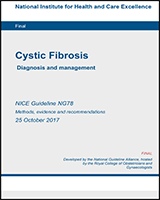| 1 FEV1% utility values | Novartis analyses of Bradley 2010 | Solem 2014:
FEV1%>70, 0.949
FEV1% 40–70, 0.918
FEV1% < 40%, 0.881 | Solem 2014 is a larger and more recent RCT that used data from a 48-week, Phase 3, multicentre study (STRIVE) to evaluate the relationship between EQ5D measures and FEV1% in 161 participants with CF. Solem 2014 was also used to inform a recent NICE TA398. |
| 2 Azithromycin exacerbation data | RR | HR | The committee regarded the time to next exacerbation for azithromycin (expressed as a HR) as more reliable than the rate of exacerbations, particularly as the study reporting this outcome was of a higher quality than those used to estimate the rate of exacerbations. |
| 3 Exacerbation cost | £6,827 | £1,220 | The cost used to inform the models developed for NICE TA276 based on asthma complications was a lot cheaper than the cost estimated from Thornton 2005. |
| 4 Number of baseline exacerbations reduced | 2.20/year inferred from the number of days in hospital and number of days on home IV antibiotics | 1.27/year inferred from the number of days in hospital | Not all home IV antibiotic treatment may relate to exacerbation treatment, so hospital treatment alone should be explored to assess the impact any potential inaccuracy. |
| 5 Ibuprofen preparation | Tablets | Oral solution | The best price available to the NHS is used to inform the base case, but more expensive preparations are available (NICE 2013 Guides to the methods of technology appraisal). |
| 6 Prednisolone preparation | Tablets | Oral solution | The best price available to the NHS is used to inform the base case, but more expensive preparations are available (NICE 2013 Guides to the methods of technology appraisal). |
| 7 Probability of ibuprofen TRAEs | Abdominal bleed 0.7%
Renal impairment 0.7% | Probabilities doubled | The committee stated the risk of abdominal bleeds and renal impairments related to long-term ibuprofen use could be higher. |
| 8 No TRAE |
| 0% | To assess the impact of TRAEs |
| 9 Within-trial (time horizon reduced to minimise extrapolation) | Lifetime (60 years) | 2 cycles from age 12 | There is considerable uncertainty surrounding the extrapolation of trial data to a lifetime horizon. |
| 10 Exacerbation cost and disutility (minor) | £6,827 and −0.095 | £1,220 and −0.015 | This scenario would be less favourable to the more effective treatments. If those treatments are still cost-effective, we can have greater confidence in the decision. |
| 11 RR for azithromycin | 0.44 | 0.2, 0.4, 0.6, 0.8, 1 over a lifetime horizon | Potentially unreliable studies were included in the NMA, particularly for azithromycin. This analysis will determine the rate of exacerbations required to change our decision regarding the cost-effectiveness of azithromycin. |
